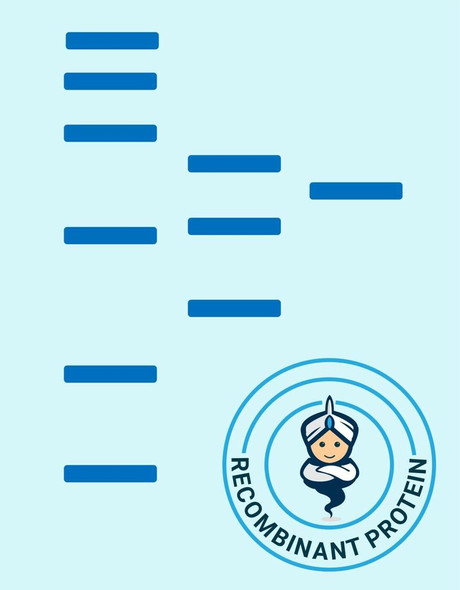Description
| Product Name: | Human CST11 Recombinant Protein |
| Product Code: | RPPB3296 |
| Size: | 20µg |
| Species: | Human |
| Target: | CST11 |
| Synonyms: | CST8L, CTES2, dJ322G13.6, SC13. |
| Source: | Escherichia Coli |
| Physical Appearance: | Sterile Filtered colorless solution. |
| Formulation: | CST11 protein solution (1mg/ml) contains 20mM Tris-HCl buffer, (pH 8.0), 0.4M urea and 10% glycerol. |
| Stability: | Store at 4°C if entire vial will be used within 2-4 weeks. Store, frozen at -20°C for longer periods of time. For long term storage it is recommended to add a carrier protein (0.1% HSA or BSA).Avoid multiple freeze-thaw cycles. |
| Purity: | Greater than 90% as determined by SDS-PAGE. |
| Amino Acid Sequence: | MGSSHHHHHH SSGLVPRGSH MGSARKKTFL SVHEVMAVEN YAKDSLQWIT DQYNKESDDK YHFRIFRVLK VQRQQVNCFF SVFAVPWFEQ YKILNKSCSS D |
Cystatin 11 (CST11) is a member of the Cystatin family. The Cystatin superfamily is comprised of proteins with multiple cystatin-like sequences. Several family members are active cysteine protease inhibitors, other family members have lost or perhaps never developed this inhibitory activity. The Cystatin superfamily consists of three inhibitory families, including the type 1 cystatins (stefins), type 2 cystatins and the kininogens. The type 2 cystatin proteins are a class of cysteine proteinase inhibitors found in a variety of human fluids and secretions. The majority of the type 2 cystatin genes and pseudogenes are contained in the cystatin locus on chromosome 20. CST11 is located in the cystatin locus and encodes an epididymal-specific protein whose specific function has not been verified yet.
CST11 Human Recombinant produced in E.Coli is a single, non-glycosylated polypeptide chain containing 101 amino acids (26-103 a.a.) and having a molecular mass of 11.8kDa.CST11 is fused to a 23 amino acid His-tag at N-terminus & purified by proprietary chromatographic techniques.
| UniProt Protein Function: | CST11: Has antibacterial activity against the Gram-negative bacteria E.coli. May play a role in sperm maturation and fertilization. Belongs to the cystatin family. 2 isoforms of the human protein are produced by alternative splicing.Chromosomal Location of Human Ortholog: 20p11.21Cellular Component: cytoplasm; nucleusMolecular Function: cysteine protease inhibitor activityBiological Process: defense response to bacterium |
| UniProt Protein Details: | |
| NCBI Summary: | The cystatin superfamily encompasses proteins that contain multiple cystatin-like sequences. Some of the members are active cysteine protease inhibitors, while others have lost or perhaps never acquired this inhibitory activity. There are three inhibitory families in the superfamily, including the type 1 cystatins (stefins), type 2 cystatins and the kininogens. The type 2 cystatin proteins are a class of cysteine proteinase inhibitors found in a variety of human fluids and secretions. The cystatin locus on chromosome 20 contains the majority of the type 2 cystatin genes and pseudogenes. This gene is located in the cystatin locus and encodes an epididymal-specific protein shown to have antimicrobial activity against E. coli. Alternative splicing yields two variants encoding distinct isoforms. [provided by RefSeq, Sep 2014] |
| UniProt Code: | Q9H112 |
| NCBI GenInfo Identifier: | 18644732 |
| NCBI Gene ID: | 140880 |
| NCBI Accession: | NP_543020.2 |
| UniProt Secondary Accession: | Q9H112,Q0VAF2, Q0VAF3, Q8WXU5, Q8WXU6, Q9H113 |
| UniProt Related Accession: | Q9H112 |
| Molecular Weight: | 12,285 Da |
| NCBI Full Name: | cystatin-11 isoform 2 |
| NCBI Synonym Full Names: | cystatin 11 |
| NCBI Official Symbol: | CST11�� |
| NCBI Official Synonym Symbols: | SC13; CST8L; CTES2; dJ322G13.6�� |
| NCBI Protein Information: | cystatin-11 |
| UniProt Protein Name: | Cystatin-11 |
| UniProt Synonym Protein Names: | |
| Protein Family: | Cystatin |
| UniProt Gene Name: | CST11�� |
| UniProt Entry Name: | CST11_HUMAN |






